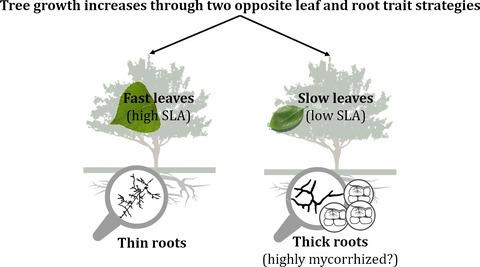Our official English website, www.x-mol.net, welcomes your
feedback! (Note: you will need to create a separate account there.)
Tree growth increases through opposing above-ground and below-ground resource strategies
Journal of Ecology ( IF 5.3 ) Pub Date : 2021-06-12 , DOI: 10.1111/1365-2745.13729 Monique Weemstra 1 , Jenny Zambrano 2 , David Allen 3 , María Natalia Umaña 1
中文翻译:

通过对立的地上和地下资源策略来增加树木的生长
更新日期:2021-06-12
Journal of Ecology ( IF 5.3 ) Pub Date : 2021-06-12 , DOI: 10.1111/1365-2745.13729 Monique Weemstra 1 , Jenny Zambrano 2 , David Allen 3 , María Natalia Umaña 1
Affiliation

|
- Studying functional traits and their relationships with tree growth has proved a powerful approach for understanding forest structure. These relationships are often expected to follow the classical resource economics perspective, where acquisitive leaves combined with acquisitive roots are expected to enhance resource uptake and tree growth. However, evidence for coordinated leaf and roots trait effects on growth is scarce and it remains poorly understood how these traits together determine tree growth. Here, we tested how leaf and root trait combinations explain tree growth.
- We collected data on leaf and root traits of 10 common tree species, and on soil carbon (C) and nitrogen (N) concentrations in a temperate forest in Michigan, US. Tree growth was calculated as the stem diameter increment between three censuses measured across 13,000 trees and modelled as a function of different combinations of leaf and root traits and soil properties.
- The two best models explaining tree growth included both specific leaf area (SLA), root diameter and soil C or N concentration, but their effects on growth were contingent on each other: thick roots were associated with high growth rates but only for trees with low SLA, and high SLA was related to fast growth but only for trees with thin roots. Soil C and N% negatively impacted the growth of trees with high SLA or high root diameter.
- Synthesis. In this study, resource economics did not explain the relationships between leaf and root traits and tree growth rates. First, for trees with low or intermediate SLA, thick roots may be considered as acquisitive, as they were associated with faster tree growth. Second, trees did not coordinate their leaf and root traits according to plant resource economics but enhanced their growth rates by combining thick (acquisitive) roots with conservative (low SLA) leaves or vice versa. Our study indicates the need to re-evaluate the combined role of leaves and roots to unveil the interacting drivers of tree growth and, ultimately, of forest structure and suggests that different adaptive whole-tree phenotypes coexist.
中文翻译:

通过对立的地上和地下资源策略来增加树木的生长
- 研究功能性状及其与树木生长的关系已被证明是了解森林结构的有效方法。这些关系通常会遵循经典资源经济学的观点,其中具有获取性的叶子与获取性的根相结合,有望增强资源吸收和树木生长。然而,关于叶和根性状对生长的协调影响的证据很少,而且人们对这些性状如何共同决定树木的生长知之甚少。在这里,我们测试了叶子和根特征组合如何解释树木的生长。
- 我们收集了 10 种常见树种的叶和根特征数据,以及美国密歇根州温带森林中土壤碳 (C) 和氮 (N) 浓度的数据。树木生长被计算为在 13,000 棵树上测量的三个普查之间的茎直径增量,并建模为叶和根性状以及土壤特性的不同组合的函数。
- 解释树木生长的两个最佳模型包括比叶面积 (SLA)、根直径和土壤 C 或 N 浓度,但它们对生长的影响取决于彼此:粗根与高生长率相关,但仅适用于低生长的树木。 SLA 和高 SLA 与快速生长有关,但仅适用于根薄的树木。土壤 C 和 N% 对具有高 SLA 或高根直径的树木的生长产生负面影响。
- 合成。在这项研究中,资源经济学没有解释叶和根性状与树木生长率之间的关系。首先,对于具有低或中等 SLA 的树木,粗根可能被认为是获得性的,因为它们与更快的树木生长有关。其次,树木没有根据植物资源经济学来协调它们的叶和根性状,而是通过将厚(获得性)根与保守(低 SLA)叶相结合来提高它们的生长速度,反之亦然。我们的研究表明需要重新评估叶和根的联合作用,以揭示树木生长以及最终森林结构的相互作用驱动因素,并表明不同的适应性全树表型共存。










































 京公网安备 11010802027423号
京公网安备 11010802027423号